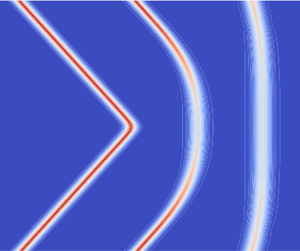Article contents
Evolution of truncated and bent gravity wave solitons: the Mach expansion problem
Published online by Cambridge University Press: 29 December 2020
Abstract

The dynamics of initially truncated and bent line solitons for the Kadomtsev–Petviashvili (KPII) equation modelling internal and surface gravity waves is analysed using modulation theory. In contrast to previous studies on obliquely interacting solitons that develop from acute incidence angles, this work focuses on initial value problems for the obtuse incidence of two or three partial line solitons, which propagate away from one another. Despite counterpropagation, significant residual soliton interactions are observed with novel physical consequences. The initial value problem for a truncated line soliton – describing the emergence of a quasi-one-dimensional soliton from a wide channel – is shown to be related to the interaction of oblique solitons. Analytical descriptions for the development of weak and strong interactions are obtained in terms of interacting simple wave solutions of modulation equations for the local soliton amplitude and slope. In the weak interaction case, the long-time evolution of truncated and large obtuse angle solitons exhibits a decaying, parabolic wave profile with temporally increasing focal length that asymptotes to a cylindrical Korteweg–de Vries soliton. In contrast, the strong interaction case of slightly obtuse interacting solitons evolves into a steady, one-dimensional line soliton with amplitude reduced by an amount proportional to the incidence slope. This strong interaction is identified with the ‘Mach expansion’ of a soliton with an expansive corner, contrasting with the well-known Mach reflection of a soliton with a compressive corner. Interestingly, the critical angles for Mach expansion and reflection are the same. Numerical simulations of the KPII equation quantitatively support the analytical findings.
Information
- Type
- JFM Papers
- Information
- Copyright
- © The Author(s), 2020. Published by Cambridge University Press
References
REFERENCES
- 12
- Cited by


